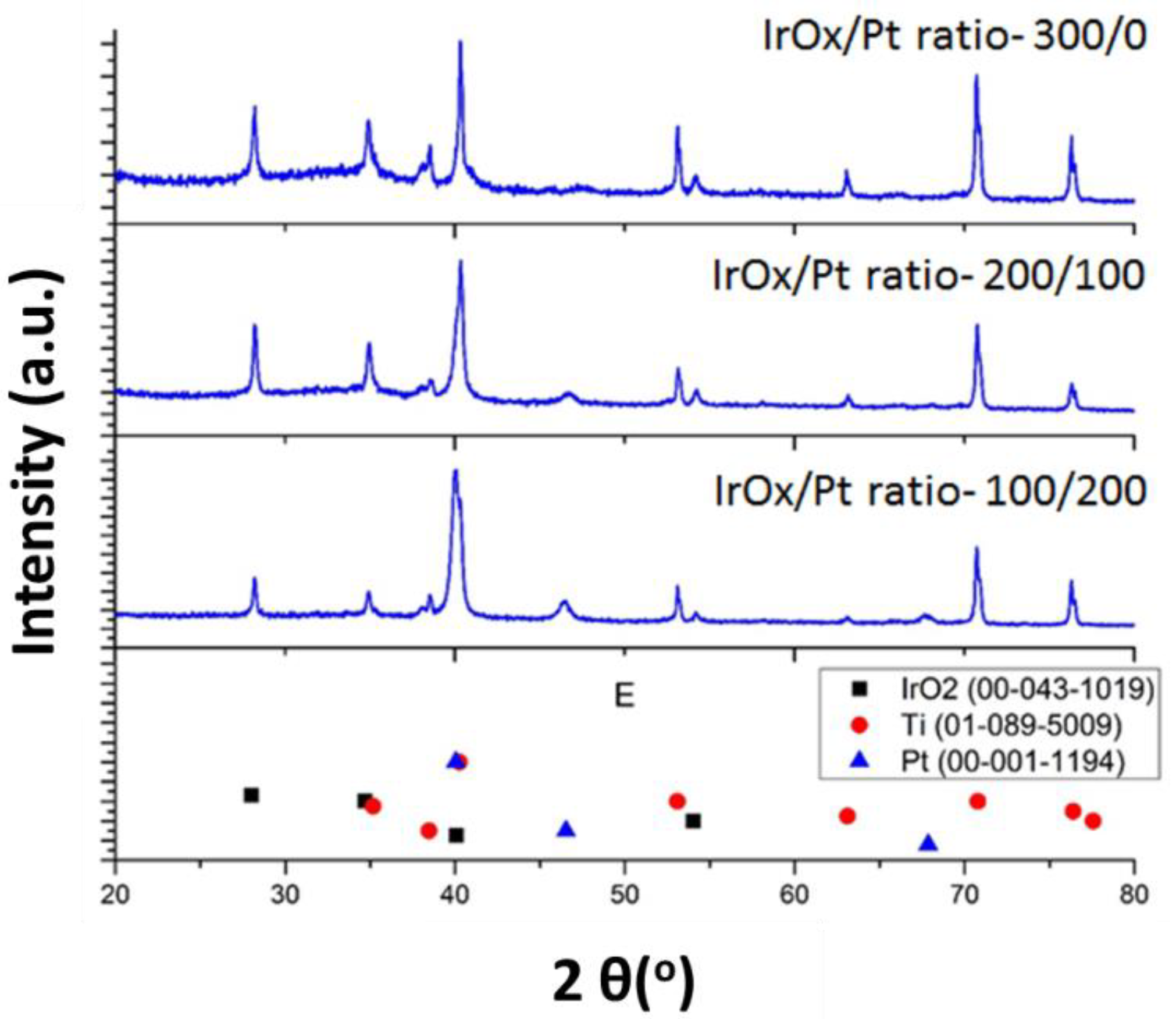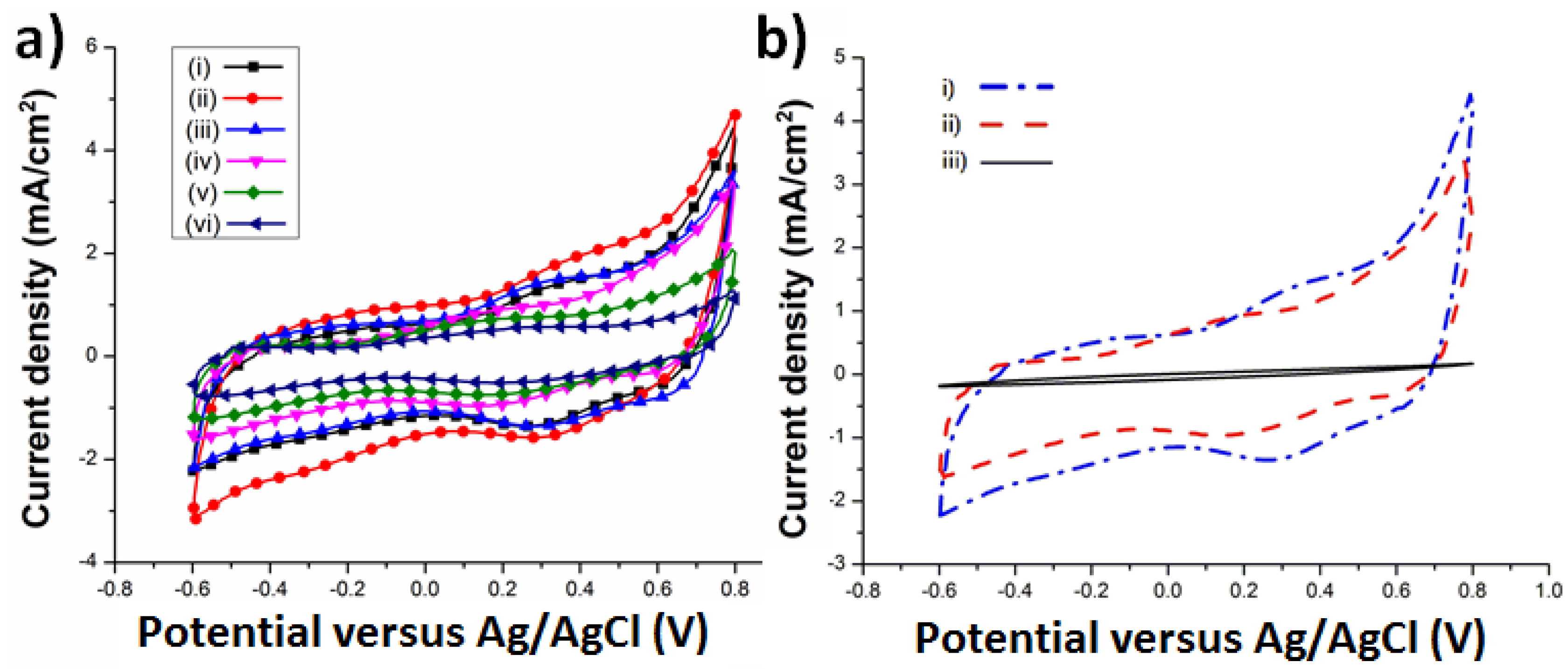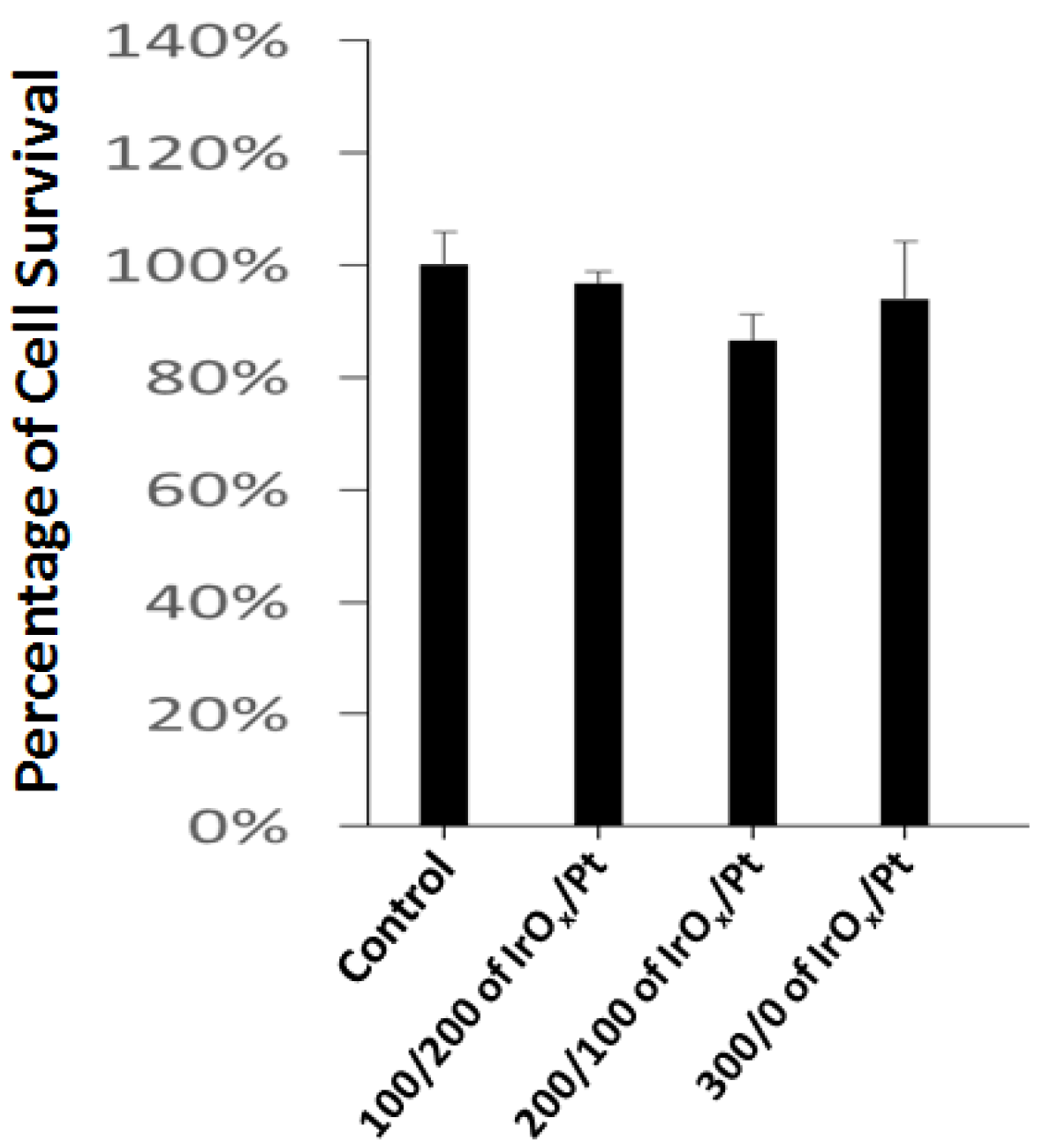Fabrication of Iridium Oxide/Platinum Composite Film on Titanium Substrate for High-Performance Neurostimulation Electrodes
Abstract
:1. Introduction
2. Materials and Methods
3. Results and Discussion
4. Conclusions
Author Contributions
Funding
Acknowledgments
Conflicts of Interest
References
- Cogan, S.F. Neural stimulation and recording electrodes. Annu. Rev. Biomed. Eng. 2008, 10, 275–309. [Google Scholar] [CrossRef] [PubMed]
- Liu, X.; Chu, P.K.; Ding, C. Surface modification of titanium, titanium alloys, and related materials for biomedical applications. Mater. Sci. Eng. R 2004, 47, 49–121. [Google Scholar] [CrossRef] [Green Version]
- Rack, H.J.; Qazi, J.I. Titanium alloys for biomedical applications. Mater. Sci. Eng. C 2006, 26, 1269–1277. [Google Scholar] [CrossRef]
- Noda, T.; Sasagawa, K.; Tokuda, T.; Terasawa, Y.; Tashiro, H.; Kanda, H.; Fujikado, T.; Ohta, J. Performance improvement and functionalization of an electrode array for retinal prosthesis by iridium oxide coating and introduction of smart-wiring technology using cmos microchips. Sens. Actuators A 2014, 211, 27–37. [Google Scholar] [CrossRef]
- Merrill, D.R.; Bikson, M.; Jefferys, J.G. Electrical stimulation of excitable tissue: Design of efficacious and safe protocols. J. Neurosci. Methods 2005, 141, 171–198. [Google Scholar] [CrossRef] [PubMed]
- Pine, J. Recording action potentials from cultured neurons with extracellular microcircuit electrodes. J. Neurosci. Methods 1980, 2, 19–31. [Google Scholar] [CrossRef]
- Pan, Y.L.; Noda, T.; Sasagawa, K.; Tokuda, T.; Ohta, J. Sputtering condition optimization of sputtered irox and tin stimulus electrodes for retinal prosthesis. IEEJ Trans. Electr. Electron. Eng. 2013, 8, 310–312. [Google Scholar] [CrossRef]
- Weiland, J.D.; Anderson, D.J.; Humayun, M.S. In vitro electrical properties for iridium oxide versus titanium nitride stimulating electrodes. IEEE Trans. Biomed. Eng. 2002, 49, 1574–1579. [Google Scholar] [CrossRef] [PubMed]
- Meyer, R.D.; Cogan, S.F.; Nguyen, T.H.; Rauh, R.D. Electrodeposited iridium oxide for neural stimulation and recording electrodes. IEEE Trans. Neural Syst. Rehabil. Eng. 2001, 9, 2–11. [Google Scholar] [CrossRef] [PubMed]
- Thanawala, S.; Palyvoda, O.; Georgiev, D.G.; Khan, S.P.; Al-Homoudi, I.A.; Newaz, G.; Auner, G. A neural cell culture study on thin film electrode materials. J. Mater. Sci. Mater. Med. 2007, 18, 1745–1752. [Google Scholar] [CrossRef] [PubMed]
- Hackwood, S.; Dayem, A.H.; Beni, G. Amorphous-nonmetal—to—crystalline-metal transition in electrochromic iridium oxide films. Phys. Rev. B 1982, 26, 471. [Google Scholar] [CrossRef]
- Wessling, B.; Besmehn, A.; Mokwa, W.; Schnakenberg, U. Reactively sputtered iridium oxide influence of plasma excitation and substrate temperature on morphology, composition, and electrochemical characteristics. J. Electrochem. Soc. 2007, 154, F83–F89. [Google Scholar] [CrossRef]
- Slavcheva, E.; Vitushinsky, R.; Mokwa, W.; Schnakenberg, U. Sputtered iridium oxide films as charge injection material for functional electrostimulation. J. Electrochem. Soc. 2004, 151, E226–E237. [Google Scholar] [CrossRef]
- Yamanaka, K. Anodically electrodeposited iridium oxide films (AEIROF) from alkaline solutions for electrochromic display devices. Jpn. J. Appl. Phys. 1989, 28, 632–637. [Google Scholar] [CrossRef]
- Robblee, L.S.; Mangaudis, M.J.; Lasinsky, E.D.; Kimball, A.G.; Brummer, S.B. Charge injection properties of thermally-prepared iridium oxide films. MRS Online Proc. Lib. Arch. 1985, 55, 303. [Google Scholar] [CrossRef]
- Chen, J.Y.; Chen, Y.M.; Sun, Y.; Lee, J.F.; Chen, S.Y.; Chen, P.C.; Wu, P.W. Chemical bath deposition of IrO2 films on ITO substrate. Ceram. Int. 2014, 40, 14983–14990. [Google Scholar] [CrossRef]
- Chen, Y.M.; Chung, T.W.; Wu, P.W.; Chen, P.C. A cost-effective fabrication of iridium oxide films as biocompatible electrostimulation electrodes for neural interface applications. J. Alloy. Compd. 2017, 692, 339–345. [Google Scholar] [CrossRef]
- Negi, S.; Bhandari, R.; Rieth, L.; Van Wagenen, R.; Solzbacher, F. Neural electrode degradation from continuous electrical stimulation: Comparison of sputtered and activated iridium oxide. J. Neurosci. Methods 2010, 186, 8–17. [Google Scholar] [CrossRef] [PubMed] [Green Version]
- Niinomi, M.; Nakai, M.; Hieda, J. Development of new metallic alloys for biomedical applications. Acta Biomater. 2012, 8, 3888–3903. [Google Scholar] [CrossRef] [PubMed]
- Chung, R.J.; Ou, K.L.; Tseng, W.K.; Liu, H.L. Controlled release of BMP-2 by chitosan/γ-PGA polyelectrolyte multilayers coating on titanium alloy promotes osteogenic differentiation in rat bone-marrow mesenchymal stem cells. Surf. Coat. Technol. 2016, 303, 283–288. [Google Scholar] [CrossRef]
- Bloyce, A.; Qi, P.Y.; Dong, H.; Bell, T. Surface modification of titanium alloys for combined improvements in corrosion and wear resistance. Surf. Coat. Technol. 1998, 107, 125–132. [Google Scholar] [CrossRef]
- Miyashita, K.; Kuroda, S.; Ubukata, T.; Ozawa, T.; Kubota, H. Enhanced effect of vacuum-deposited SiO2 overlayer on photo-induced hydrophilicity of TiO2 film. J. Mater. Sci. 2001, 36, 3877–3884. [Google Scholar] [CrossRef]
- Negi, S.; Bhandari, R.; Rieth, L.; Solzbacher, F. In vitro comparison of sputtered iridium oxide and platinum-coated neural implantable microelectrode arrays. Biomed. Mater. 2010, 5, 015007. [Google Scholar] [CrossRef] [PubMed]
- Boehler, C.; Oberueber, F.; Schlabach, S.; Stieglitz, T.; Asplund, M. Long-term stable adhesion for conducting polymers in biomedical applications: IrOx and nanostructured platinum solve the chronic challenge. ACS Appl. Mater. Interfaces 2016, 9, 189–197. [Google Scholar] [CrossRef] [PubMed]
- Zeng, Q.; Xia, K.; Sun, B.; Yin, Y.; Wu, T.; Humayun, M.S. Electrodeposited iridium oxide on platinum nanocones for improving neural stimulation microelectrodes. Electrochim. Acta 2017, 237, 152–159. [Google Scholar] [CrossRef]
- Wu, Y.J.; Chung, T.W.; Huang, J.Q.; Wu, P.W.; Chen, P.C.; Lee, J.F.; Chan, T.S. Conformal deposition of Pt on titania nanotubes to produce a bio-electrode for neuro-stimulating applications. Electrochem. Commun. 2018, 88, 61–66. [Google Scholar] [CrossRef]
- Göbbels, K.; Kuenzel, T.; van Ooyen, A.; Baumgartner, W.; Schnakenberg, U.; Bräunig, P. Neuronal cell growth on iridium oxide. Biomaterials 2010, 31, 1055–1067. [Google Scholar] [CrossRef] [PubMed]






| IrOx/Pt Ratio | Contact Angle |
|---|---|
| 0/100 | 59.44 |
| 100/200 | 24.48 |
| 200/100 | 12.22 |
| 300/0 | 5.58 |
© 2018 by the authors. Licensee MDPI, Basel, Switzerland. This article is an open access article distributed under the terms and conditions of the Creative Commons Attribution (CC BY) license (http://creativecommons.org/licenses/by/4.0/).
Share and Cite
Chung, T.-W.; Huang, C.-N.; Chen, P.-C.; Noda, T.; Tokuda, T.; Ohta, J. Fabrication of Iridium Oxide/Platinum Composite Film on Titanium Substrate for High-Performance Neurostimulation Electrodes. Coatings 2018, 8, 420. https://doi.org/10.3390/coatings8120420
Chung T-W, Huang C-N, Chen P-C, Noda T, Tokuda T, Ohta J. Fabrication of Iridium Oxide/Platinum Composite Film on Titanium Substrate for High-Performance Neurostimulation Electrodes. Coatings. 2018; 8(12):420. https://doi.org/10.3390/coatings8120420
Chicago/Turabian StyleChung, Tsai-Wei, Chih-Ning Huang, Po-Chun Chen, Toshihiko Noda, Takashi Tokuda, and Jun Ohta. 2018. "Fabrication of Iridium Oxide/Platinum Composite Film on Titanium Substrate for High-Performance Neurostimulation Electrodes" Coatings 8, no. 12: 420. https://doi.org/10.3390/coatings8120420
APA StyleChung, T.-W., Huang, C.-N., Chen, P.-C., Noda, T., Tokuda, T., & Ohta, J. (2018). Fabrication of Iridium Oxide/Platinum Composite Film on Titanium Substrate for High-Performance Neurostimulation Electrodes. Coatings, 8(12), 420. https://doi.org/10.3390/coatings8120420






